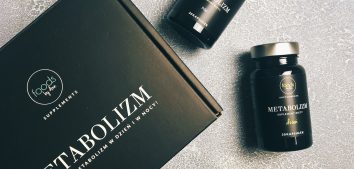
Probiotic – how to choose the best one?
The author of today’s post is Patrycja Szachta, Ph.D. in biological sciences, Director for Scientific Affairs at VitaImmun Medical Center in Poznań.
Probiotics are live mcroorganisms which support the functioning of our digestive tract, and as a result our whole body, have enjoyed unflagging interest for over a dozen years. It is hardly surprising – appropriately adjusted probiotic supplementation contributes to a noticeable improvement in mental and physical condition. Remember that the dominance of health-promoting bacteria in our digestive tract is not only the proper bowel function, but also a much better mood (the intestine is called a second brain for a reason), proper work of the immune system, regulation of metabolic processes in the body and a number of other advantages.
However, the question is how to choose a probiotic, considering our current health condition, for the supplementation to bring the desired effect? This is not an easy matter, because the pharmaceutical market offers a huge number of various supplements, all of which unfortunately are not high-quality preparations.
Therefore, in this article you will find the most important principles that should be followed when choosing a probiotic to bring the desired health effect.
1.Choose probiotics in a targeted way
What does it mean? The choice of the right preparation can be compared to choosing the right antibiotic. If we have a problem with upper respiratory tract infection, our physician will prescribe us a medicine that solves this exact problem. In turn, if we have a problem with a bacterial infection of the urogenital tract, we will get a completely different antibiotic. Probiotic supplements should be chosen in a similar fashion. Specific probiotic strains have a targeted effect – in scientific studies they have been shown to be effective in alleviating or supporting the treatment of specific disease entities. The same probiotic will be great for relieving the symptoms of irritable bowel syndrome, but will be less effective in a patient with recurrent infections. Another probiotic strain will be effective in preventing or shortening the duration of the so-called “stomach flu” (rotavirus infection), but won’t help a patient with constipation. Therefore, we can see that choosing the right supplement is a key issue for the effectiveness of probiotics. If you do not know which probiotics you should choose, it is worth to seek the advice of a person specializing in probiotic therapy, who will tell you which preparations will be most suitable for us. In case of serious health problems, it is worth to perform an assessment of the microbiota of our intestines, through which it will be possible to match the appropriate probiotics, taking into account the health condition of the patient (eg MikroFloraScan).
2. Choose safe, tested and high quality probiotics
As it was mentioned before, not all probiotics available on our market are of high quality. Due to the ease of the registration process, the vast majority of probiotics are registered as dietary supplements, which is associated with much smaller restrictions than the registration of a product as a non-prescription drug (OTC). For this reason, we can find both tested, safe and effective probiotics as well as supplements with a probiotic which, apart from the name, have little in common with the real thing.
Let me remind you the definition of of a probiotic – it is a specific strain of bacteria which, administered in certain doses will have a beneficial effect on health.
Simply put, the bacterial strain determines the properties it exhibits. Certain probiotic strains have the ability to improve the functioning of our immune system, the production of vitamins B and K, the production of intestinal barrier sealing compounds, the effective displacement of fungi or pathogenic bacteria from the gastrointestinal tract. Some of them even affect the production of serotonin, and can be treated as so-called psychobiotic or probiotics “for the mood”. These properties are strain dependent, which means that the characteristics of one bacterial strain cannot be attributed to another, even a closely related one. A specified probiotic strain must be accurately described – with a generic name (eg Lactobacillus), species (rhamnosus), but also collection number of strain culture (patent) under which the given strain is deposited (eg. ATCC 53103, Bb 12, 299 v). In other words, if a given probiotic contains microorganisms described only with the generic and species name, e.g. Lactobacillus rhamnosus, Lactobacillus planatrum, Bifidobacterium bifidum, etc., this does not mean that it is a probiotic. We should look for supplements described in detail, eg Lactobacillus rhamnosus GG ATCC 53103 (LGG), Bifidobacterium bifidum Bb12, Lactobacillus plantarum 299 v, Lactobacillus acidophillus NCFB 1748 etc. When we see a description of this type on the packaging we can check what properties the strain in this preparation has and in which diseases it can be recommended and effective. Internet sources (eg medical databases) will be helpful here.
The high number of strains in the product is extremely important for the quality of the probiotic. For a probiotic strain to work effectively, it must be in a very high amount, because a significant portion of the bacteria will be digested in the upper parts of the digestive tract before it reaches the large intestine where it is supposed to exert health-promoting effects. The minimum number of bacteria in a probiotic dose must be at least 109 cfu / g of the preparation (in the case of probiotic bacteria) and 250 mg in the case of non-pathogenic probiotic yeasts (Saccharomyces boulardii). In other words, we should look for preparations which contain at least this amount of microorganisms.
It is also important that the declared number of probiotic bacteria in the preparation is preserved throughout its shelf life. The analyses performed showed that in a large number of probiotics, the number of live bacteria in the preparation significantly decreases during the storage period. High-quality probiotics are controlled by the manufacturer for abundance throughout the entire period, so that regardless of the time elapsed since production, they will have the same health properties.
Unfortunately, the choice of a recognized probiotic strain and maintaining the viability of the bacteria in the preparation over a longer period of time requires considerable financial outlay. For this reason, another feature that we have to pay attention to when buying a probiotic is its price. In other words – a good probiotic can not be cheap. It’s not possible to produce a high quality supplement for $5.
When talking about quality, it is necessary to raise the issue of the safety of probiotic preparations. All strains used in probiotics must meet the GRAS criteria, i.e. Generally Recognized as Safe. These are microorganisms belonging to the genus Bifidobacterium and Lactobacillus and non-pathogenic yeast Saccharomyces boulardii. However, we should remember that these strains can’t be used in all patients without exception. Caution should be exercised especially in patients with dysfunctions of the immune system (acquired and congenital immunodeficiency), patients with cancer, cardiovascular diseases, and systemic infection. In these groups of patients, probiotics should be used with particular care and adjusted by a specialist every time.
It is still controversial to use strains of the genus Enterococcus and the Escherichia coli species in the production of probiotic preparations. Despite studies showing the effectiveness of these bacteria in certain clinical situations, there are concerns about their natural resistance (especially Enterococcus spp.) to a range of antibiotics. Researchers fear that this trait may potentially be passed on to bacteria that inhabit the digestive tract, which would be an inadvisable situation. For this reason, at the moment, some researchers recommend the use of the described bacteria of the genus Enterococcus only in probiotics intended for animals.
We should also remember that the majority of probiotics available on the Polish market is intended for children over 3 years of age. If we want to support the microbiota of a toddler, who has not yet reached this age, we must look for preparations intended for newborns, infants and small children.
3. Yogurt and sour pickles are not probiotics
It is quite common to believe that “pharmacy” probiotics can be successfully replaced by the introduction of fermented dairy products into the diet (yogurt, acidophilus milk, kefir) or sour pickles (pickled cucumbers, sauerkraut). Well, it’s not quite the right thing to do. By the term probiotic we mean microorganisms isolated from the human gastrointestinal tract (feces of a healthy child or adult) with a confirmed profile of action and safety. As a matter of fact, human germs should not be present in fermented milk products. There are LAB bacteria (lactic acid bacteria) which belong to the genus Lactobacillus and Bifidobacterium, as well as microbes contained in pharmacy probiotics. However, we can’t assume that they work in the same way as the strains contained in pharmaceutical preparations. As previously mentioned, probiotic strains must be thoroughly tested – in terms of effectiveness in specific clinical situations, with regard to the safety of use and survival of bacteria in the gastrointestinal tract. As a result, they have confirmed and documented action in the prevention and treatment of a number of diseases.
It is certain that bacteria contained in fermented products support our intestinal microbiota and are an important element of a balanced, rational diet, but they can’t be considered as a “probiotic drug”. What’s more, to achieve the beneficial effect of such a natural “probiotic diet”, comparable to the receipt of pharmacy probiotics, one would have to consume even a few kilograms of yogurt a day! We should also remember that the number of bacteria in fermented milk products changes dynamically during the storage period, which may prevent them from benefiting the body..
Probiotic products are another issue, i.e. yogurts enriched with specific probiotic bacteria, which we consider to be so-called functional food. High-quality products containing probiotics have a measurable positive effect on our health. An interesting alternative for people looking for “natural” probiotics are also probiotic drinks, also available on the Polish market. They do not contain milk proteins, which is especially important for people with allergies and intolerance to dairy products.
4. Take probiotics as prescribed by a specialist
To increase the effectiveness of probiotics, they should be taken in a specific way. First, probiotics should be consumed with a meal that will “protect” the probiotic strains to a large extent before being digested in the upper parts of the digestive tract. This will increase the effectiveness of the described supplements.
If we use more than one probiotic, we should try to take them at certain intervals, for example, one with a morning meal and another one in the evening. The strains contained in probiotic preparations can fight each other. By accepting several probiotics at the same time, instead of double or triple efficiency, we might not achieve any effect at all.
Another important issue is the use of a probiotic in the form in which we purchased it. In other words – if we decide to take a supplement in the form of a capsule, do not open it before consumption. It is a protective element designed to protect health-promoting strains from the action of hydrochloric acid and bile salts. If you have a problem with swallowing the capsule, choose the form of a sachet or probiotic drops.
We should also remember to use probiotics for a specific period of time. Contrary to popular belief, the probiotics we use do not colonize our digestive tract “forever” but only for a (rather short) period of time. This is called the ability to transient colonization. The real purpose of using probiotics is in fact to support our own (indigenous) intestinal bacteria and to create such favorable conditions in the intestine so that our pro-health microorganisms can reproduce effectively. So you can compare probiotics to a friendly army, which supports our own army in the fight against the enemy (pathogenic bacteria, fungi and other pathogens in the intestine), but after winning the battle, it leaves the battlefield (i.e. our intestine). However, in order for this “battle” to be won, we must allow enough time for it to happen. For this reason, a probiotic supplementation that lasts several days must also be time-adjusted. For example, research has shown that antibiotic therapy can damage our microbiota even for a few months. Therefore, the use of probiotics only for the duration of antibiotics is not sufficient for our intestinal ecosystem. Similarly, scientific research has shown that to support our immune system if we have a problem with recurrent infections, even a few months of probiotic supplementation is necessary.
Therefore, we can see that choosing the right, safe and effective probiotic is not an easy matter. However, it is worth to take the trouble to choose the right product for us. Properly adapted probiotic supplementation has visible effects on the improvement of our health and well-being. Sometimes it is worth to use the help of a professional who will assess which probiotics are optimal for us, or … delve into the fascinating topic of the microbiome of our intestines on your own.
The words of Hippocrates from 2500 years ago can be quoted here: “Let food be your medicine and medicine be your food.” The main point is for the drug to be properly selected.
References:
- Reuter G., Present and future of probiotics in Germany and in Central Europe. Bioscience and Microflora 1997, 16: 43.
- Holzapfel W.H., Haberer P., Snel J. et al. Overview of gut flora and probiotics. Internat J Food Microbiol 1998,41: 85–101.
- Hamilton-Miller J.M.T., Shah S., Winkler J.T. et al.: Public health issues arising from microbiological and labeling quality of foods and supplements containing probiotic microorganisms. Public Health Nutr 1999, 2:223–9.
- Hoa N.T., Baccigalupi L., Huxham A. et al. Characterization of Bacillus species used for oral bacteriotherapy and bacterioprophylaxis of gastrointestinal disorders. Appl Environ Microbiol 2000, 66, 5241–7.
- Saxelin M., Saxelin M., Lassig A. et al. Persistence of probiotic strains in the gastrointestinal tract when administered as capsules, yoghurt, or cheese. Int J Food Microbiol 2010, 15(144): 293–300.
- Dirienzo D.B. Effect of probiotics on biomarkers of cardiovascular disease: implications for heart-healthy diets. Nutr Rev. 2014;72:18–29. doi: 10.1111/ nure.12084.
- Bednorz C., Guenther S., Oelgeschläger K., Kinnemann B., Pieper R., Hartmann S., Tedin K., Semmler T., Neumann K., Schierack P., Bethe A., Wieler L.H. Feeding the probiotic Enterococcus faecium strain NCIMB 10415 to piglets specifically reduces the number of Escherichia coli pathotypes that adhere to the gut mucosa. Appl. Environ. Microbiol. 2013;79:7896–7904. doi: 10.1128/AEM.03138-13.
- Cao G.T., Zeng X.F., Chen A.G., Zhou L., Zhang L., Xiao Y.P., Yang C.M. Effects of a probiotic, Enterococcus faecium, on growth performance, intestinal morphology, immune response, and cecal microflora in broiler chickens challenged with Escherichia coli K88. Poult. Sci. 2013;92:2949–2955. doi: 10.3382/ps.2013-03366.
- Lutyńska A., Augustynowicz E., Wiatrzyk A. Problemy stosowania suplementów diety zawierających bakterie kwasu mlekowego. Probl Hig Epidemiol 2012, 93(3): 493–498.











Comments No Comments
Join the discussion…